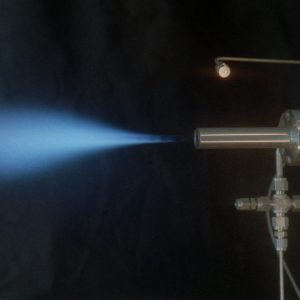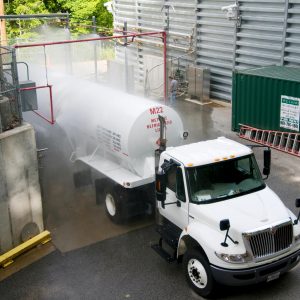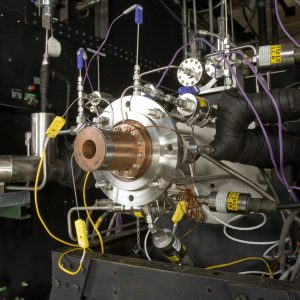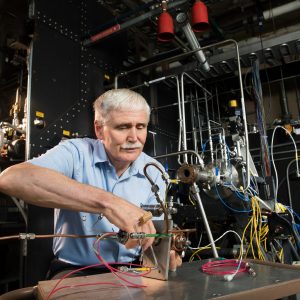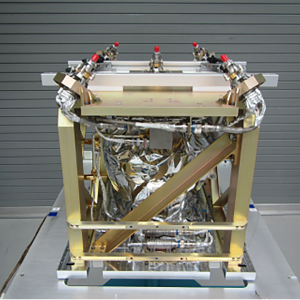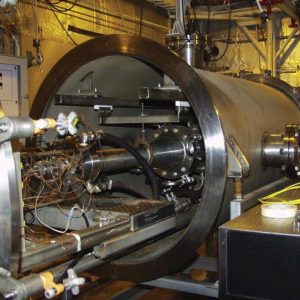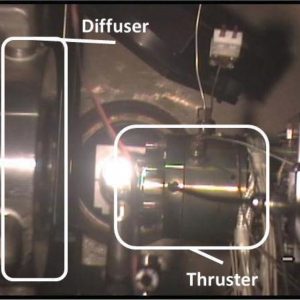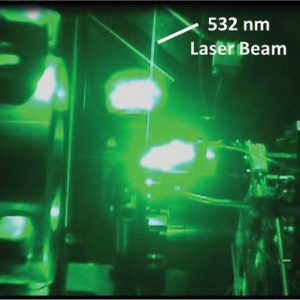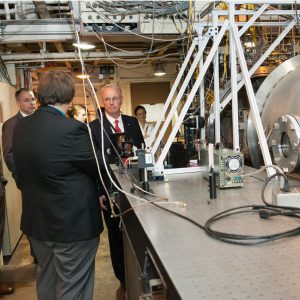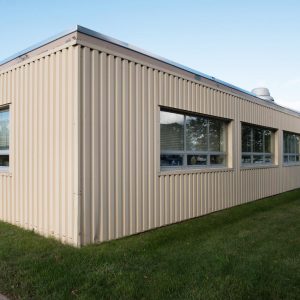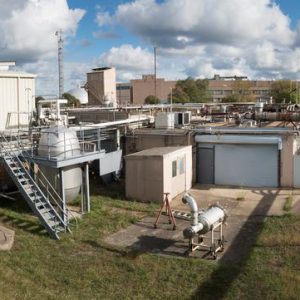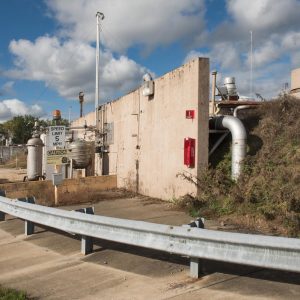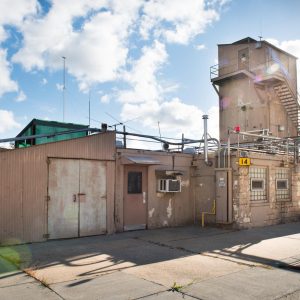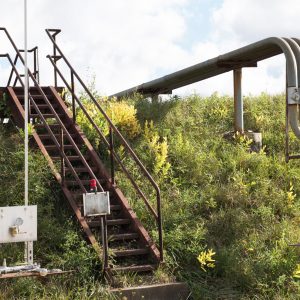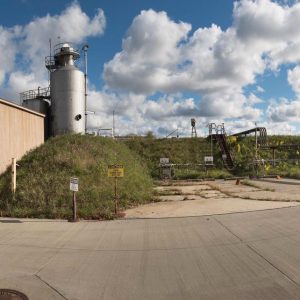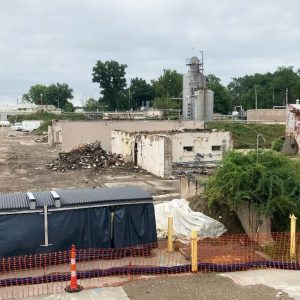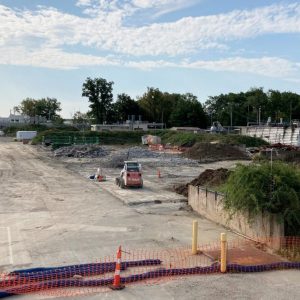Final Years
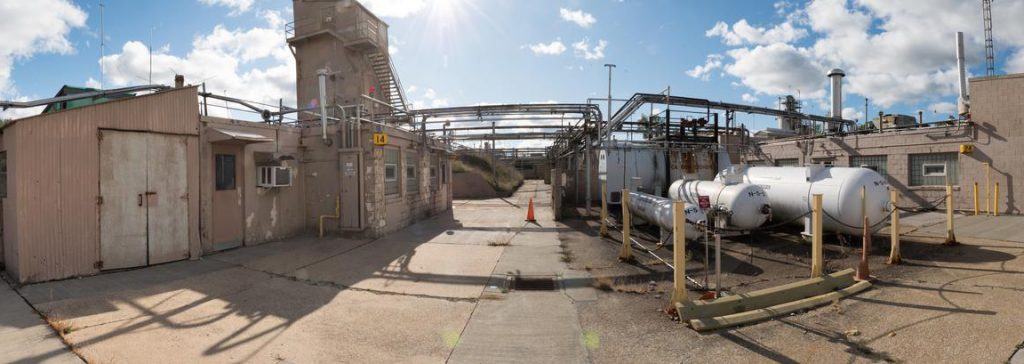
Overview
In the 2000s, NASA began systematically removing many of its older or under-used structures to reduce annual maintenance obligations. The Glenn Research Center closely scrutinized all of its facilities, including the Rocket Laboratory. Center management decided to consolidate the capabilities of the various Rocket Lab test cells into new structures and demolish the rest.
Nonetheless, four of the Rocket Lab test cells remained active throughout the 2000s, and Cell 21 was rehabbed. During these final years, Glenn researchers used the Rocket Lab to study new technologies such as “green” propellants and low-cost injectors. After 75 years of research, the Rocket Lab complex was demolished in 2021.
Methane for Thruster Systems
In 2004, the agency announced the Constellation Program, a new effort to return to the Moon and send humans to Mars. One of NASA Glenn’s roles was determining the feasibility of using reaction-control thrusters fueled by liquid oxygen-liquid methane for the Orion vehicle. Methane has a greater density than hydrogen so would require smaller tanks. Methane was also less toxic than hydrazine and other contemporary thruster fuels and was naturally present in the solar system. The Center investigated a number of engine components for methane engines in the 1960s, but the technology was shelved.
Since liquid oxygen-methane was not a hypergolic propellant, it was critical that the propulsion system included reliable and totally redundant igniters. In 2005, Glenn engineers designed a torch igniter system specifically to study ignition of the liquid oxygen-methane combination. The altitude stand in Cell 21 became the primary testbed for these studies. In 2005, a spark torch igniter for a liquid oxygen-methane thruster was tested in Cell 21 with varying propellant mixtures to determine the consistency of the pulses and the component’s lifetime. The igniter was successfully tested 750 times over a range of temperatures and pressures. Further testing determined the igniter’s fuel-rich boundary layer.
Cell 21 was also used to test secondary ignition sources for the liquid oxygen-methane engines. Automotive glow plugs were found to provide adequate ignition, but there was concern that they would not warm up quickly enough in case of abort scenarios. The performance of a Glenn-designed microtube-based catalytic ignition system, which was designed to provide low-power ignition source for liquid oxygen-methane systems, was successfully demonstrated in Cell 21 in 2010.
Documents
- Design, Fabrication, and Test of a LOX/LCH4 RCS Igniter at NASA (2007)
- LOX-methane glow plug igniter tests (2009)
- Testing of Methane/Oxygen Catalytic Microtube Ignition System (2012)
Green Propellants
In recent years, the space community has been interested in “green” monopropellants for future spacecraft thrusters. These propellants not only have higher densities and specific impulses than the currently-used hydrazine but are less toxic and dangerous. NASA’s Green Propellant Infusion Mission Program (GPIM) sought to determine the performance of a green monopropellant (AF-M315E) in a thruster on a small technology demonstration spacecraft.
Because the fuel’s exhaust contains water, there was some concern that the thruster’s exhaust plume might condense and damage solar arrays or optical equipment. Glenn researchers sought to verify extensive computer modelling by testing the thruster in Cell 11 at the Rocket Lab.
In 2013, researchers tested two thruster models dozens of times in the facility’s altitude chamber. They used Rayleigh and Raman spectroscopy, as well as Schlieren imaging to measure the plume and evaluate the potential impingement and deposition effects on the spacecraft and solar arrays. This was followed by steady-state and pulse testing in June 2014 to correlate and verify the modelling predictions.
The Space X Dragon Falcon Heavy launched the GPIM into orbit on June 25, 2019. Over the next 13 months, the spacecraft successfully demonstrated the green propellant’s application.
Documents
- Overview of Glenn’s Green Propellant Infusion Mission Thruster Testing (2014)
- Green Propellant Infusion Mission Program Development and Technology Maturation (2014)
- Green Propellant Infusion Mission Program Development (2014)
Low-Cost Rocket Components
NASA initiated the Manufacturing Innovation Project (MIP), which sought new methods of developing complex rocket engine components at low costs. In 2012, Pratt & Whitney Rocketdyne was contracted to design the injectors and water-cooled combustion chambers. NASA Glenn was responsible for the igniter assembly, heat sink combustion chamber, and nozzle for the injector. In June 2013, the injector was demonstrated in Cell 32 at the Rocket Lab.
Documents
Closing the Facility
NASA has been working ardently to reduce its physical footprint since the early 2000s. This has primarily focused on the removal of mothballed and under-utilized structures. The work areas in many of them had declined over the years while annual maintenance costs have risen. The demolitions included historically significant, but idle, facilities such as the Altitude Wind Tunnel and Propulsion Systems Laboratory No. 1 and 2.
During this period, the center also initiated an intensive master plan to transform its campus. This plan included the consolidation and removal of the various buildings at the Rocket Lab and the adjacent materials research area. Center management calculated that it would be more efficient to replace the necessary Rocket Lab buildings rather than attempt to renovate them. One of the biggest issues at the facility was mold accumulation in the heating and ventilation systems.
Demolition
The Rocket Lab demolition required the rerouting of utilities and the removal of the buildings, foundations, and parking areas. The center began the process in August 2016 with an environmental characterization study and utility rerouting plan. The plan called for the removal of 25 structures, including eight of the test cells and five support structures.
After a brief delay due to the Covid pandemic, the Rocket Lab was demolished in 2021.

